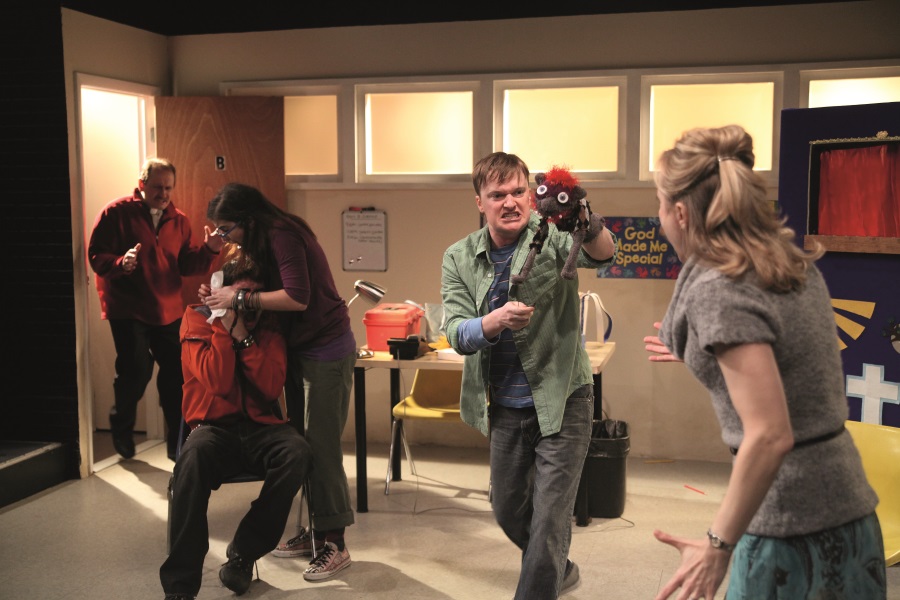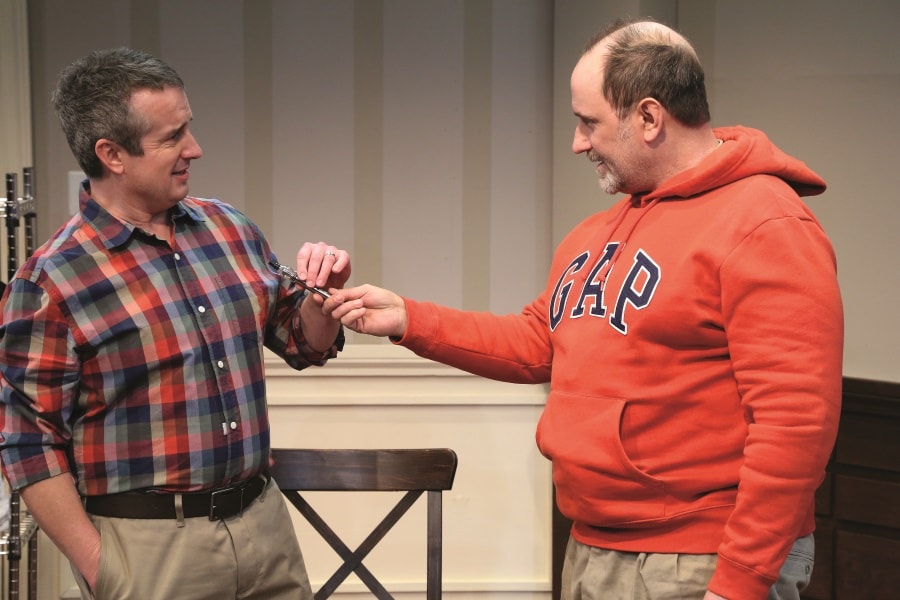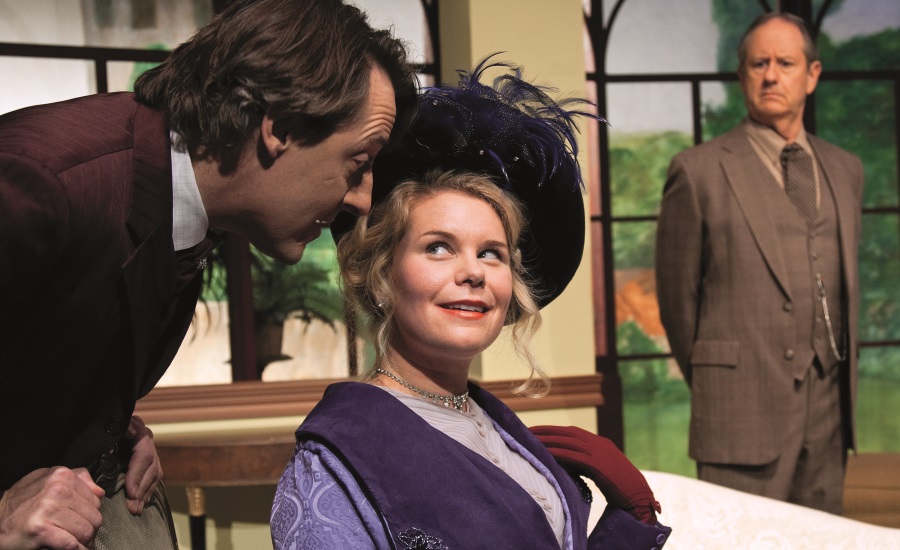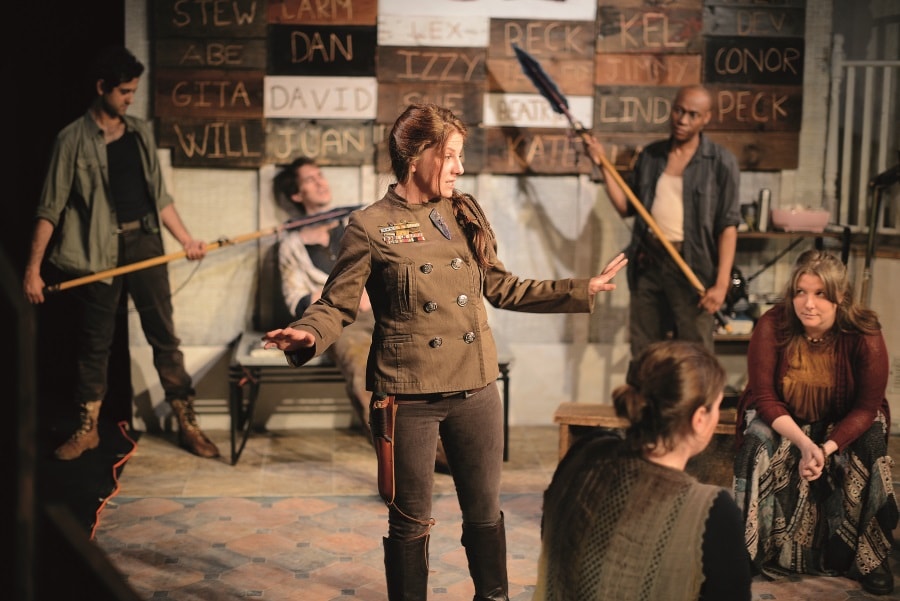The recent battle between Actors Equity Association and the Los Angeles theatre community was about a number of things: the relationship between actors and their union, whether acting is a job or a vocation, the best ways to encourage the growth of an artistic community. But underneath those issues lurked a larger, thornier issue: money. Whether we admit it or not, money shapes our theatres and our theatrical work, and yet we rarely talk about it openly.
At the heights of the 99-seat fight earlier this year, social media was ablaze with theatre artists from all over the country, and indeed the world, weighing in on whether or not L.A. actors should be paid the minimum wage for their work, as Equity was newly insisting. In all of the back-and-forth of invective, comparisons and contrasts with other theatre communities became a common discussion point. Some claimed that, under rules like Equity’s proposed plan, a show like Robert Askins’s Hand to God, which started in a tiny 99-seat black box under New York’s Showcase Code, couldn’t happen (and certainly shows like Rogue Machine’s Small Engine Parts or Theatre @ Boston Court’s Everything You Touch, both originated under L.A.’s 99-Seat Plan before transferring to theatres Off-Broadway, would have had a harder time getting started). Others warned that the new rules would lead to L.A.’s unique theatre culture turning into something like Chicago’s storefront scene, which is dominated by non-Equity companies. Either way, the underlying argument was the same: L.A. theatres can’t afford to pay actors like theatres in other cities can.
But is L.A.’s theatre economy so vastly different from the rest of the country that it warrants a different set of considerations? That question can’t be answered definitively. But considering it as a question of money, of math, maybe a baseline—a bottom line, if you will—can be established.
Of course, making art costs money, and art, particularly non-commercial art, rarely makes it back. But the capital to pay actors, rent space, build sets and costumes, keep the spotlights humming—that capital must come from somewhere. It’s raised, it’s budgeted, and then it’s spent. How all three of those steps happen tells us something about an organization, about its priorities, and about its community. If we’re going to ask what’s best for our theatres, we might start by following the money.
This is not to suggest that theatre is “about” money, or that money should talk the loudest and have the last word on everything. But if we are going to look at different theatre scenes and try to define what’s working and what isn’t, budget is a useful starting point. While Equity defines theatres by numbers of seats, Theatre Communications Group (TCG) divides by budget size. Budget size gives us a sense of the scope of a theatre and what might be expected from it. It may not be the most nimble measure, but it is an industry standard.
Comparing budgets and expenses for theatres of a similar size (99 seats or less) in the nation’s major theatre cities reveals some interesting similarities and differences. While theatre of all sizes exists all over the country, and certainly small theatres and theatre companies power the artistic life of cities of all sizes, the troika of New York City, Chicago, and Los Angeles have the greatest concentrations of what is called by some “indie” theatre. What we find there tells us much about the way the art and business of theatre gets done in the U.S. today.
The small theatre scene in New York falls under the oldest, most established small production agreement, the Showcase Code. It allows for a small company to produce a play for a limited run (16 performances) with a small stipend for AEA actors (transit to and from rehearsals and performances, in practice meaning a monthly pass for the NYC subway, currently $116). There are strict limits on rehearsal hours, the ability to extend or remount, and rights to record performances. These last prescriptions tend to be the focal point of complaints about the system.
The Showcase Code dates from the bad old days when there were few if any protections for actors working in small theatres. It is technically not a contract but a code of conduct that lays out a set of baseline expectations. Under the code, small theatres in NYC have flourished, and a full-fledged community has developed.
Youngblood at Ensemble Studio Theatre has grown into a central part of that community. Once a weekly playwrights’ meeting that sometimes presented readings and workshops, Youngblood now produces a full season of events, including full-length productions, anchored by monthly brunches—free-wheeling presentations of short plays with a shared theme, served with bacon, eggs, and bottomless mimosas. (For the record, I’m an artist member of EST and I helped run Youngblood for two years in the mid-2000s.)
Hand to God was born in Youngblood, nurtured in the weekly meetings, and supported at every step along the way. The original production extended five times, playing to sold-out houses and glowing reviews. It went on to a second production at MCC Theater, and is currently in the midst of a Tony-nominated run on Broadway. How did it begin? And what did it cost to get there?

Askins’s play was originally produced under a variation of the Showcase Code, the Seasonal Showcase Code, which is available to theatres that produce more than three shows in a given season. The restrictions on budget and performances are slightly relaxed, and actors’ pay is determined by the theatre’s production budget. Youngblood’s annual production budget is $60,000. The Seasonal Showcase code requires 15 percent of that annual budget be divided pro rata among all actors, which comes to $9,000. RJ Tolan, one of Youngblood’s two artistic directors, says they often exceed the minimum required to pay the actors, sometimes by as much as 10 percent more. Under the Seasonal Showcase, performances are capped at 20 over a period of 6 weeks. After that, if the show wants to extend, it jumps to a Mini-Contract, the lowest-level Equity contract for NYC, which means the actors get $400 per week and restrictions on filming are loosened. If a theatre wants to mount a second production of a play on a Showcase Code, they have to wait 12 months.
Youngblood is, of course, a special case, since it’s connected to the Ensemble Studio Theatre. Youngblood’s annual operating budget sits at about $100,000, and as they mainly operate out of EST’s Hell’s Kitchen home, they don’t pay rent. Their ticket revenue ranges $30,000-50,000 a year, and they also raise about $60,000 in foundation support, earmarked directly for Youngblood.
What about companies without the rent-free largesse and brand name of a 40-year-old New York institution behind them? Gideon Productions was founded by playwright Mac Rogers, director Jordana Williams, and producer/actor Sean Williams. They’ve mainly produced Mac’s plays, directed by Jordana, often featuring Sean. It’s a family affair (Sean is married to Jordana, and Mac is married to resident set designer Sandy Yaklin), but a winning one. Mac’s sci-fi “geek” plays are met with sellout audiences, glowing reviews, and awards from the NY indie community.
As essentially a mom-and-pop company, Gideon has done things in an ad hoc manner. They don’t necessarily have “seasons.” They’ve produced their shows on the Showcase Code but have always paid more than the minimums. “When we started, we paid actors $200 a week, because I came from the professional world and it never occurred to me that actors could possibly work for less,” Sean writes in an email. “That ended up being something like $1,400 an actor, and we lost our shirts.”
After that, they sought ways to put up shows without losing their shirts, while still paying actors significantly more than the required minimum. Though they’re planning to move to the Seasonal Showcase next season, currently their shows come in around $18,000 each, with the big-ticket items being space rental and personnel. In a three-show year, their annual budget hits $50,000. Gideon raises most of its funds from private donations. As essentially a startup—even after nearly a decade at it—their staff are the artists, the artists are the staff. They fundraise for themselves.
If there’s any way that the Showcase Code is a stumbling block, Sean says it’s in the way one of its provisos constrains fundraising.
“Almost all the truly meaty grants require video,” Williams notes. “We’re not allowed to shoot video under any circumstance. You’re allowed to request the right to shoot video, provided you get all the AEA members to sign off on it, but I don’t know a single production company who has been allowed. AEA firmly says no.”

As the home of Broadway, Off-Broadway, indie theatre, and touring companies, New York is obviously the American theatre’s industrial capital, and as such, it is spoken of in other cities with a blend of envy, reverence, and defiance. It may not be fair to compare other cities to the high-pressure, high-expense, high-risk, high-yield environment of New York. But as AEA considers itself a national union, and American Theatre is a national magazine, comparisons are inevitable.
If any city in America can challenge New York’s claim, it’s Chicago. America’s “Second City” boasts as variegated a theatrical landscape as New York, from the flagship Goodman to gritty storefront theatres. Around the country, its rep is as a city where an artist can do their work and have a “real life.”
The storefront scene is the engine of the Chicago’s theatre. It’s also mainly non-union. Indeed, the city’s non-union scene is so entrenched that the annual Joseph Jefferson Awards, given for theatrical excellence, have a non-Equity wing alongside the Equity one. There was a kerfuffle earlier this year when it was found that one of the companies given a non-Equity Jeff, the Hypocrites, was actually working under an Equity agreement.
Unlike similar-sized theatres in New York, many small non-Equity theatres in Chicago rent their own spaces on an ongoing basis. New York real estate makes that nearly impossible for most companies. Chicago not only has lower overhead; it also famously has a fellow feeling. Artists have day jobs and theatres connect with their community; there’s a strong sense of camaraderie.
“There is so much pride in the storefront scene—a small, intimate, gritty culture,” says Julie Ritchey of the Filament Theatre Company. Filament works in a folk tradition, generating new work and adaptations, with a core of resident artists. In other words, not exactly the most commercial approach. Money is still, of course, an issue. Filament’s annual budget comes in at $120,000, with overhead on their rented space taking the lion’s share. As Filament has four shows in its 2015 season, that comes to roughly $30,000 per show.
The theatre’s budget shot way up, of course, when they started renting their Portage Park home and added a part-time staff of two (the other two staff members receive a stipend). Being a non-Equity theatre means they’re not required to pay their actors, but Filament has made a commitment to paying its actors something. “Our budget reflects our value,” Julie says. They want to avoid a situation, for instance, where budget for the set dwarfs the money paid to actors. That has meant making some tough calls, such casting an ensemble of just six actors for a season. The hope, though, is to eventually move toward a living wage for the artists.
Funding that commitment, and their work, is a blend of individual donors, foundation grants, rental income, and ticket sales. Community engagement is key for their future; becoming an Equity theatre isn’t really a priority. There’s a mutual respect with the Equity scene—but no sense that the Equity is the “real” theatre.
A few blocks north of the Filament sits the Gift Theatre, which is a rarity in Chicago: a storefront Equity theatre. An ensemble started by University of Iowa students in 1997, the Gift evolved into an Equity house shortly after they moved into their space, says artistic director Michael Patrick Thornton.
When asked what their big-ticket budget items are, Thornton is pretty blunt.
“Two-thirds of the show budget is for actor pay. That’s why Equity storefronts are rare. It’s cost-prohibitive.” The Gift produces on a CAT 1 Equity contract, with the actors paid between $300-$500 per show, depending on cast size. Their annual budget hovers just below $450,000, with roughly $30,000 spent on space per year. But Thornton says it would cost them a lot more to rent space on a show-by-show basis.
The move into their own space sparked a maturing process for the Gift. “Taking care of each other meant we had to grow up, introduce ourselves to new people, convert them to art lovers,” says Thornton. “We had to do the un-sexy thing that, when you’re starting out, makes your eyes glaze over.”

Those new art lovers are the key to running an ensemble theatre company in a 40-seat house. In order to cover the costs of larger-cast shows, the Gift gets “sponsorships,” a program started by board member Brian Dowling. This season, the sponsorships have bumped the two or three Equity contracts they started with to 7. “We looked at our numbers, went to our subscribers and said, ‘We don’t want to keep people on the bench.’” It took shoe leather and time to build those connections, and to build their staff. Their board has gone from all ensemble members to 50 percent artist members and 50 percent contributors. “The goal isn’t to survive, but to build this thing,” Thornton says.
If anything was lost along the way from their DIY days, Thornton says it was worth it. “Where we are right now is where the Gift has always been trying to tell us it wanted to be,” he says. “When we started, we knew what we wanted the company to feel like, but we had no idea how much it would cost. Now we do. Now we have the model.”
The Filament and the Gift offer two divergent ways a theatre might grow from DIY origins into a more institutionalized, more structured organization. In Los Angeles, which gives Chicago a run for its money as a small-theatre capital, there are also models for growth—one of them proposed and then passed by Equity, over strong objections from many of its members. Scheduled to go into effect next April (unless a recent lawsuit filed a consortium of “Pro-99” members holds that up), it mandates that even the town’s smallest theatres pay every union actor minimum wage for each hour of performance and rehearsal. This was not only not the norm under the L.A.’s old 99-Seat Plan, in which actors volunteered in return for small stipends; it is also not required by New York’s Showcase Code, and obviously doesn’t apply to Chicago’s non-union storefronts.
Of course, it’s not hard to see why L.A.’s 99-seat theatre scene invited Equity’s scrutiny: It ranges from postage-stamp-sized rental houses with microbudgets to million-dollar facilities. But as long they had venues with fewer than 100 seats, they were united by the 99-Seat Plan—a kind of détente between the upstart theatremakers of Los Angeles and the distant powers of Actors Equity that followed the bitter Equity Waiver wars of the 1980s. You might view the time between the plan’s institution and the contentious present moment as a period of benign (or maybe not so benign) neglect. But while the gardeners weren’t watching, something took root and flowered.
Many theatre companies in L.A. are actor-based, formed by groups of actors looking to work together. Many are multifaceted artists, hyphenates of all kinds. A let’s-put-on-a-show spirit infuses the scene. In most cases, though, of course, the plucky kids putting on the show in the barn are highly accomplished artists with MFAs from prestigious universities, years of acting experience, and even fame and fortune in TV and film.
One such company, a stalwart of the 99-seat scene, is Sacred Fools. In its 19 years it’s birthed several hit shows, most recently Stoneface, Vanessa Claire Stewart’s play about the life and times of Buster Keaton, which moved to a contract run at the Pasadena Playhouse. Apart from creating the occasional hit, the Fools are known for innovative shows, a series of late-night shorts called Serial Killers, and for their large membership. They’re about as L.A. theatre as you can imagine.

When you speak with Padraic Duffy, the company’s managing director (also a playwright), you can feel his passion for the work and the theatre. He’s the only staff member, paid a small stipend for managing the company’s finances and space. Like many companies in L.A., Sacred Fools operates fully as an ensemble. Each season, three company members step up as artistic directors and put together the season. The plays are developed by the ensemble, produced by the ensemble, star the ensemble. It’s all homegrown.
But Padraic describes the theatre’s fundraising as being stuck in a kind of catch-22. “You want to grow, but there’s no time for that, because you’re so busy,” he says. Busy indeed: With five productions* every season, along with Serial Killers, the theatre is producing nearly every week of the year. It pays off, in its way: Sacred Fools sells out regularly, bringing in the vast majority of its $200,000 annual budget in ticket sales. They have a small handful of individual donors, a small board, and little foundation support. “California doesn’t offer the kind of grants that a state like New York does,” Padraic says.
Under the old 99-Seat Plan, still in effect through next April, actors receive between $7 and $25 dollars per show. Duffy says Sacred Fools always pays above the minimum, but still less than what actors get in New York. That keeps show budgets in the $5,000-$7,000 range. That sounds small, but there’s also rent, which eats up nearly half of the theatre’s annual budget. Their hectic production schedule means there are few opportunities to rent the space to outside companies for income.
If you look at their budget another way, amortizing the rent over their five productions, Sacred Fools’ shows cost in the neighborhood of $25,000 each**—not far off from what a similar production might cost in New York or Chicago. And paying for a dedicated space, as opposed to being itinerant and renting show-to-show, is largely a given in L.A. theatre. With Los Angeles’ well-documented traffic/parking issues, the reluctance of people to travel, and the far-flung nature of Los Angeles county, having a space is seen as essential to maintaining a company. It’s considered just the price of doing business.
Even the relatively smaller Theatre of NOTE has a space of its own. Like Sacred Fools, it’s entirely artist-driven. Democratically run, NOTE has no permanent staff and no artistic director, with all decisions flowing out of a series of revolving committees. One company member, the fortuitously named John Money, heads up the Finance Committee, and might be the closest thing to a “managing director” they have.
“It’s a kind of socialist, libertarian paradise,” says Money. Committees select the development slate, pick the productions. Theatre of NOTE provides the space, the infrastructure, but each play has a producer who’s responsible for raising funds for their show. There is a board of directors that pitches in on fundraising, but mostly, it’s on the producer.
NOTE, like Sacred Fools, has large fixed costs: Roughly 75 percent of its $110,000-$125,000 annual budget goes to rent and insurance. The shows are budgeted at $8,000-$12,000. About a third comes in via ticket sales. The rest of their budget comes from a mix of grants, donations, and subscriptions. It’s a month-to-month battle for them to make the rent, but Money says it’s worth it.
“It’s rough to maintain a membership company without a space,” he says. “The energy dissipates. Physically having a space is a blessing.”
Both Money and Duffy contend that the new Equity mandate to pay actors minimum wage would make the kind of theatre they do impossible. It’s easy to see why: If you leave out the cost of the space, production budgets that max out in the low five figures are hard to beat. But with overhead taking up so much of their budgets, there’s little breathing room.
There are also the trade-offs like the ones the Gift’s Thornton mentioned—the “un-sexy” work of institutionalizing. The loose, open nature of the old 99-Seat Plan has allowed artist collectives to thrive and flourish. Asking them to change their very nature, to build up boards and infrastructure, would alter that. Something would definitely be lost. Who’s to say if that’s worth the cost?

Small theatres span the width of our country and a full breadth of artistic expression. But there are things that unite them: a DIY spirit, a desire for connection with each other and with the audience, and questions about how—or whether—to grow. Whether a nomadic company renting space for each show, or ensconced in a larger organization, or a DIY collective, all face a struggle to raise funds and pay bills. But that’s only the beginning. How the money is spent is as important as how it’s raised.
Raising the veil on these questions—essentially opening our books to each other—is an important step. If we can advance the conversation about how the money we raise is spent, then we can have an honest conversation about the different ways it might be spent, even should be spent, and what that might mean for the field.
We’re also likely to find out we all have more in common than we realized. We all have artistic goals, we all have bottom lines, and we all struggle to make the twain meet. If we can share these struggles, rather than using our own as cudgels against each other, we might find our burdens a bit lighter.
*The article originally stated that Sacred Fools produces three shows a season. **The original figure cited was $40,000.
J. Holtham writes things in Los Angeles these days. You can find him on Twitter (@jholtham) or Tumblr (jholtham).


